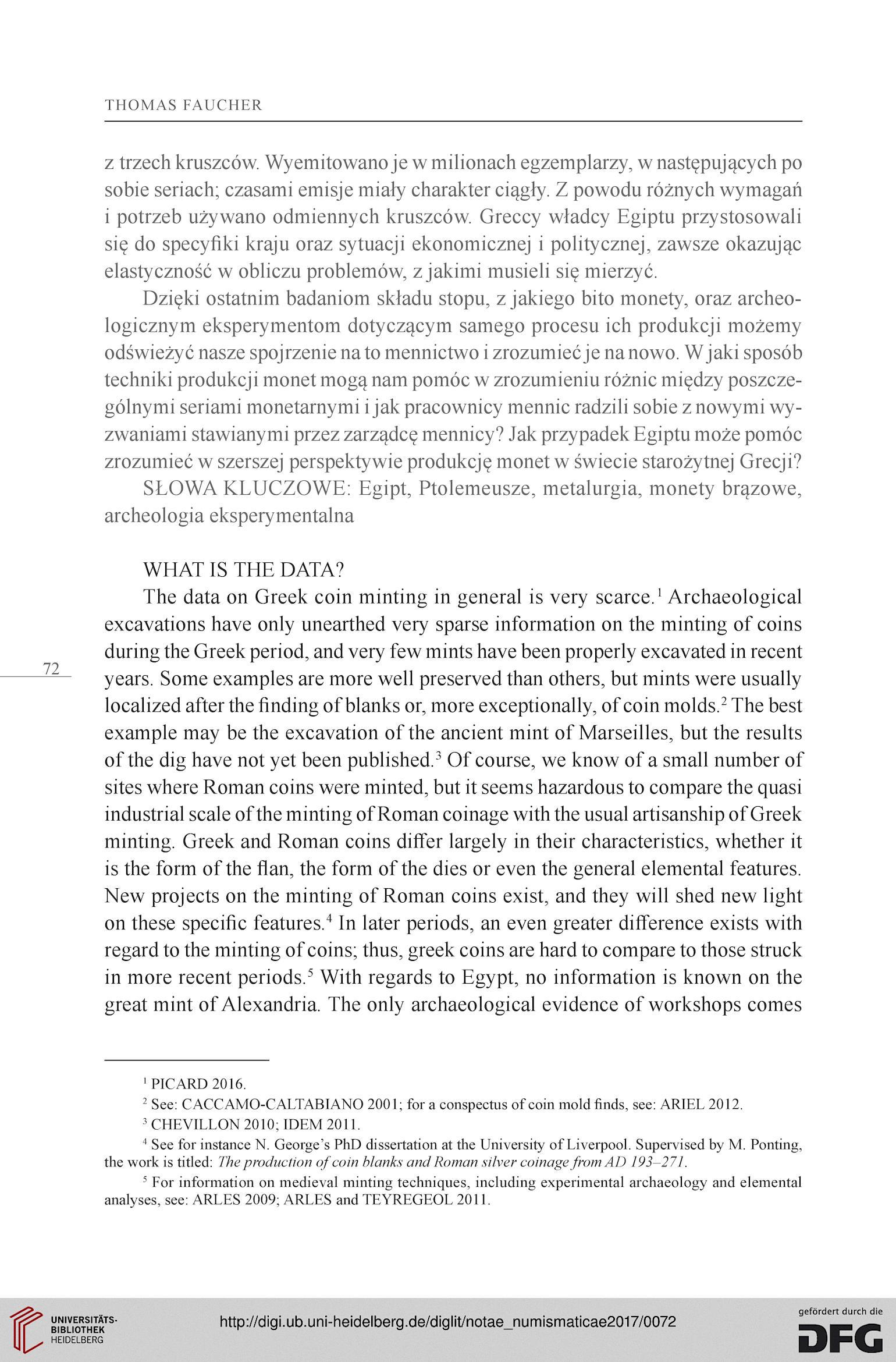THOMAS FAUCHER
z trzech kruszców. Wyemitowano je w milionach egzemplarzy, w następujących po
sobie seriach; czasami emisje miały charakter ciągły. Z powodu różnych wymagań
i potrzeb używano odmiennych kruszców. Greccy władcy Egiptu przystosowali
się do specyfiki kraju oraz sytuacji ekonomicznej i politycznej, zawsze okazując
elastyczność w obliczu problemów, z jakimi musieli się mierzyć.
Dzięki ostatnim badaniom składu stopu, z jakiego bito monety, oraz archeo-
logicznym eksperymentom dotyczącym samego procesu ich produkcji możemy
odświeżyć nasze spojrzenie na to mennictwo i zrozumieć je na nowo. W jaki sposób
techniki produkcji monet mogą nam pomóc w zrozumieniu różnic między poszcze-
gólnymi seriami monetarnymi i jak pracownicy mennic radzili sobie z nowymi wy-
zwaniami stawianymi przez zarządcę mennicy? Jak przypadek Egiptu może pomóc
zrozumieć w szerszej perspektywie produkcję monet w świecie starożytnej Grecji?
SŁOWA KLUCZOWE: Egipt, Ptolemeusze, metalurgia, monety brązowe,
archeologia eksperymentalna
WHAT IS THE DATA?
The data on Greek coin minting in general is very scarce.1 Archaeological
excavations have only unearthed very sparse information on the minting of coins
during the Greek period, and very few mints have been properly excavated in recent
years. Some examples are morę well preserved than others, but mints were usually
localized after the finding of blanks or, more exceptionally, of coin molds.2 The best
example may be the excavation of the ancient mint of Marseilles, but the results
of the dig have not yet been published.3 Of course, we know of a small number of
sites where Roman coins were minted, but it seems hazardous to compare the quasi
industrial scale of the minting of Roman coinage with the usual artisanship of Greek
minting. Greek and Roman coins differ largely in their characteristics, whether it
is the form of the flan, the form of the dies or even the general elemental features.
New projects on the minting of Roman coins exist, and they will shed new light
on these specific features.4 In later periods, an even greater difference exists with
regard to the minting of coins; thus, greek coins are hard to compare to those struck
in more recent periods.5 With regards to Egypt, no information is known on the
great mint of Alexandria. The only archaeological evidence of workshops comes
'PICARD 2016.
2 See: CACCAMO-CALTABIANO 2001; for a conspectus of coin mold finds, see: ARIEL 2012.
3 CHEVILLON 2010; IDEM 2011.
4 See for instance N. George’s PhD dissertation at the University of Liverpool. Supervised by M. Ponting,
the work is titled: The production of coin blanks and Roman silver coinage fromAD 193-271.
5 For information on medieval minting techniques, including experimental archaeology and elemental
analyses, see: ARLES 2009; ARLES and TEYREGEOL 2011.
z trzech kruszców. Wyemitowano je w milionach egzemplarzy, w następujących po
sobie seriach; czasami emisje miały charakter ciągły. Z powodu różnych wymagań
i potrzeb używano odmiennych kruszców. Greccy władcy Egiptu przystosowali
się do specyfiki kraju oraz sytuacji ekonomicznej i politycznej, zawsze okazując
elastyczność w obliczu problemów, z jakimi musieli się mierzyć.
Dzięki ostatnim badaniom składu stopu, z jakiego bito monety, oraz archeo-
logicznym eksperymentom dotyczącym samego procesu ich produkcji możemy
odświeżyć nasze spojrzenie na to mennictwo i zrozumieć je na nowo. W jaki sposób
techniki produkcji monet mogą nam pomóc w zrozumieniu różnic między poszcze-
gólnymi seriami monetarnymi i jak pracownicy mennic radzili sobie z nowymi wy-
zwaniami stawianymi przez zarządcę mennicy? Jak przypadek Egiptu może pomóc
zrozumieć w szerszej perspektywie produkcję monet w świecie starożytnej Grecji?
SŁOWA KLUCZOWE: Egipt, Ptolemeusze, metalurgia, monety brązowe,
archeologia eksperymentalna
WHAT IS THE DATA?
The data on Greek coin minting in general is very scarce.1 Archaeological
excavations have only unearthed very sparse information on the minting of coins
during the Greek period, and very few mints have been properly excavated in recent
years. Some examples are morę well preserved than others, but mints were usually
localized after the finding of blanks or, more exceptionally, of coin molds.2 The best
example may be the excavation of the ancient mint of Marseilles, but the results
of the dig have not yet been published.3 Of course, we know of a small number of
sites where Roman coins were minted, but it seems hazardous to compare the quasi
industrial scale of the minting of Roman coinage with the usual artisanship of Greek
minting. Greek and Roman coins differ largely in their characteristics, whether it
is the form of the flan, the form of the dies or even the general elemental features.
New projects on the minting of Roman coins exist, and they will shed new light
on these specific features.4 In later periods, an even greater difference exists with
regard to the minting of coins; thus, greek coins are hard to compare to those struck
in more recent periods.5 With regards to Egypt, no information is known on the
great mint of Alexandria. The only archaeological evidence of workshops comes
'PICARD 2016.
2 See: CACCAMO-CALTABIANO 2001; for a conspectus of coin mold finds, see: ARIEL 2012.
3 CHEVILLON 2010; IDEM 2011.
4 See for instance N. George’s PhD dissertation at the University of Liverpool. Supervised by M. Ponting,
the work is titled: The production of coin blanks and Roman silver coinage fromAD 193-271.
5 For information on medieval minting techniques, including experimental archaeology and elemental
analyses, see: ARLES 2009; ARLES and TEYREGEOL 2011.




